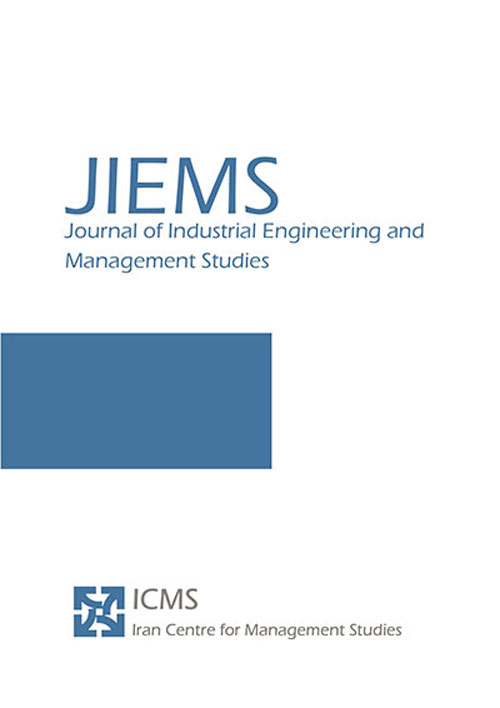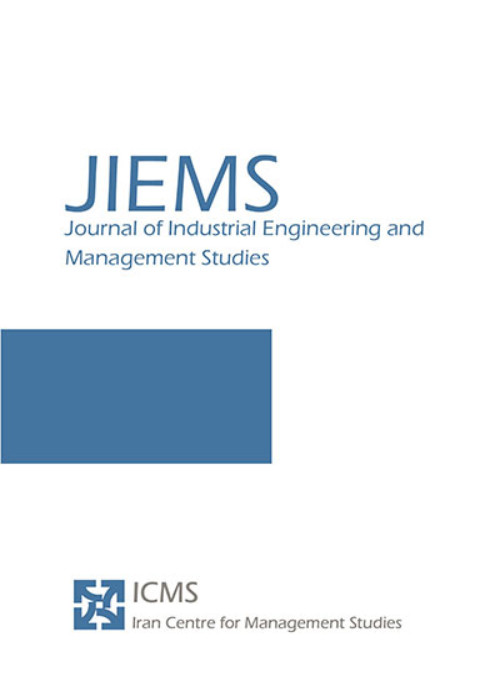فهرست مطالب

Journal of Industrial Engineering and Management Studies
Volume:5 Issue: 1, Winter-Spring 2018
- تاریخ انتشار: 1397/01/30
- تعداد عناوین: 6
-
-
Pages 1-25One of the main challenges of strategic management is implementing the strategies. Designing the strategy map in Balanced Scorecard framework to determine the causality between strategic objectives is one of the most important issues in implementing the strategies. In designing the strategy map with intuition and judgment, the link between strategic objectives is not clear and it is not obvious which strategic objectives are related and influenced each other. Hence, it is essential to offer a quantitative and accurate method to design the strategy map and clarify these relationships. In this paper, after reviewing the methods for determining the causal relationships among BSC perspectives in the literature, a framework on the basis of historical data analysis and multi-response surface regression analysis is offered to determine causal relationships among strategic objectives with respect to data of key performance measures of past years in order to obtain the coefficients and equations that can be used in the prediction of the responses. Using statistically significant models, the correlations between the factors and several responses were acquired. The presented quantitative approach is useful for determining the causal relationships resulting in an accurate strategy map and is a supporting approach for improving decision makers opinions and enabling them to reach a more accurate picture of the relationships. This research also presents a case study to demonstrate the applicability of the proposed approach. The application and implication of the proposed method in a real case show that the contributions of the research are not only theoretical but practical as well. The strategy map constructed in this study can also serve as a reference point for similar businesses.Keywords: Strategy Maps, Balanced Scorecard, Key Performance Indicators, Statistical Modeling, ANOVA
-
Pages 26-42Today, in the existing competitive market, proper management of the supply chain has attracted a lot of attention to increasing profitability and customer satisfaction. Managers and decision-makers may use policies to survive in this situation, but a desirable outcome will only come when a precise and comprehensive model is used. Therefore, a detailed design and systematic planning of the supply chain seems necessary with all levels and units in order to increase the efficiency of the entire supply chain. In this research, two main objectives will be considered using multi-objective optimization methods. The first goal is to minimize the total cost of locating the warehouses in the supply chain, and the second goal is to maximize the level of customer satisfaction and service level of Bonny Chow Company. Computational results show the acceptable performance of the proposed method on a set of real-sized instances and demonstrate its efficiency in solving generated scenarios.Keywords: Locations, Distribution warehouses, Multi-objective optimization, Transportation cost
-
Pages 43-65Super-efficiency model in the presence of negative data is a relatively neglected issue in the DEA field. The existing super-efficiency models have some shortcomings in practice. In this paper, a novel VRS radial super-efficiency DEA model based on Directional Distance Function (DDF) is proposed to provide a complete ranking order of units (including efficient and inefficient ones). The proposed model is feasible no matter whether data are non-negative or not. This model shows more reliability on differentiating efficient units from inefficient ones via a new bounded super-efficiency measure. It can project each unit onto the super-efficiency frontier along a new non-negative direction and produce improved targets for inefficient units. The model overcomes the infeasibility issues occur in NerloveLuenberger supper-efficiency model. The proposed model conveys good properties such as monotonicity, unit invariance and translation invariance. Apart from numerical examples, an empirical study in bank sector demonstrates the superiority of the proposed model.Keywords: Data Envelopment Analysis, Super-efficiency model, Negative data, DDF model
-
Pages 66-84Organizations have found that functional approach to business destroys flexibility and agility by gaining experience over the time. The main weakness with Task-based organizations is that they can hardly act flexibly and adapt themselves to the changing environment. In today's dynamic and competitive business world, organizations focus significantly on managing and improving their business processes. Therefore, nowadays to be survived and successful, certainly, the process approach must be followed. In addition, organizations having such improvement and innovations are looking to create organizational wealth. In this regard, the present study is trying to identify and describe processes from reputable reference models in Customer Relationship Management (CRM) and more importantly to design and streamline CRM processes effectively for organizations in order to improve processes and offer value to customers. In this paper, first, by identifying and explaining CRM reference models, three models were selected based on five criteria (flexibility, Understandability, comprehensiveness, Completeness, and Usability) using Analytic Hierarchy Process (AHP) technique which is relative as follow: SAP, CCOR & PCF. Then, the processes of the three models were extracted and gathered in a comprehensive list to offer a united framework to design CRM processes. Finally, a case study will show the applicability of the proposed model. With this paper, we enrich research by a valuable process framework for developing well-designed reference models.Keywords: CRM Reference Models, Process design, AHP, QFD
-
Pages 85-105Reliability is a fundamental factor in the operation of bus transportation systems for the reason that it signifies a straight indicator of the quality of service and operators costs. Todays, the application of GPS technology in bus systems provides big data availability, though it brings the difficulties of data preprocessing in a methodical approach. In this study, the principal component analysis is utilized to systematically assess the reliability indicators based on automatic vehicle location (AVL) data. In addition, the significant reliability indicators affecting the bus reliability are identified using a statistical analysis framework. The proposed bus reliability assessment framework can be applied to each bus route or a complete network. The proposed methodology has been validated using computational experiments on real-world AVL datasets extracted from the bus system in Qazvin, Iran. The analysis indicates that 1) on-time performance, 2) headway regularity, 3) standard deviation of the travel time of the buses, and 4) 50th percentile travel time are key indicators the reliability of bus services. The potential of the proposed methodology is discussed to provide insights for bus operators. Using the proposed approach in the article, the desirable reliability status of bus lines is identifiable from the point of view of key stakeholders, and the ways to improve reliability can be more clearly defined.Keywords: AVL data, bus reliability, regression analysis, mobility management
-
Pages 106-121In this paper, it was an attempt to be present a practical perishability inventory model. The proposed model adds using spoilage of products and variable prices within a time period to a recently published location-inventory-routing model in order to make it more realistic. Aforementioned model by integration of strategic, tactical and operational level decisions produces better results for supply chains. Due to the NP-hard nature of this model, a genetic algorithm with unique chromosome representation is used to achieve the optimal solution and reasonable time. Finally, the analysis is carried out to verify the effectiveness of the algorithm with and without considering the cost of spoiled products.Keywords: Perishability inventory model, Facility location, Vehicle routing, Inventory management, Spoiled products, Genetic Algorithm


